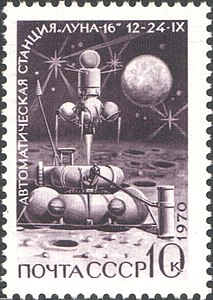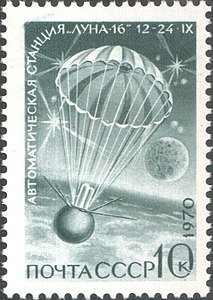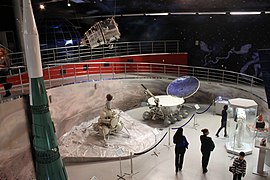
Lunokhod 2 was the second of two uncrewed lunar rovers that landed on the Moon by the Soviet Union as part of the Lunokhod programme.

The Surveyor program was a NASA program that, from June 1966 through January 1968, sent seven robotic spacecraft to the surface of the Moon. Its primary goal was to demonstrate the feasibility of soft landings on the Moon. The Surveyor craft were the first American spacecraft to achieve soft landing on an extraterrestrial body. The missions called for the craft to travel directly to the Moon on an impact trajectory, a journey that lasted 63 to 65 hours, and ended with a deceleration of just over three minutes to a soft landing.

Luna 9 (Луна-9), internal designation Ye-6 No.13, was an uncrewed space mission of the Soviet Union's Luna programme. On 3 February 1966, the Luna 9 spacecraft became the first spacecraft to achieve a survivable landing on a celestial body and return imagery from its surface.
Luna 14 was an uncrewed space mission of the Luna program run by the Soviet Union. It was also called Lunik 14.

Luna 15 was a robotic space mission of the Soviet Luna programme, that was in lunar orbit together with the Apollo 11 Command module Columbia.

Luna 17 was an uncrewed space mission of the Luna program, also called Lunik 17. It deployed the first robotic rover onto the surface of the Moon.

Luna 18, part of the Ye-8-5 series, was an uncrewed space mission of the Luna program.

Luna 20 was the second of three successful Soviet lunar sample return missions. It was flown as part of the Luna program as a robotic competitor to the six successful Apollo lunar sample return missions.

Luna 21 was an uncrewed space mission, and its spacecraft, of the Luna program, also called Lunik 21, in 1973. The spacecraft landed on the Moon and deployed the second Soviet lunar rover, Lunokhod 2. The primary objectives of the mission were to collect images of the lunar surface, examine ambient light levels to determine the feasibility of astronomical observations from the Moon, perform laser ranging experiments from Earth, observe solar X-rays, measure local magnetic fields, and study mechanical properties of the lunar surface material.

Luna 23 was an uncrewed space mission of the Luna program developed by the Soviet Union.

Luna 24 was a robotic probe of the Soviet Union's Luna programme. The 24th mission of the Luna series of spacecraft, the mission of the Luna 24 probe was the third Soviet mission to return lunar soil samples from the Moon. The probe landed in Mare Crisium. The mission returned 170.1 g (6.00 oz) of lunar samples to the Earth on 22 August 1976.
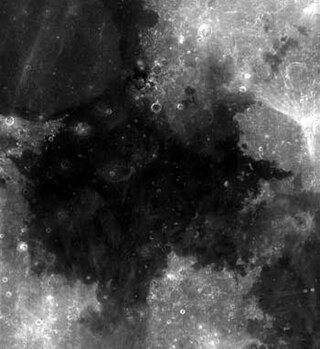
Mare Tranquillitatis is a lunar mare that sits within the Tranquillitatis basin on the Moon. It is the first location on another celestial body to be visited by humans.
Kosmos 60 was an E-6 No.9 probe, launched by the Soviet Union. It was the sixth attempt at a lunar soft-landing mission, with a design similar to that of Luna 4.

A Moon landing or lunar landing is the arrival of a spacecraft on the surface of the Moon, including both crewed and robotic missions. The first human-made object to touch the Moon was Luna 2 in 1959.
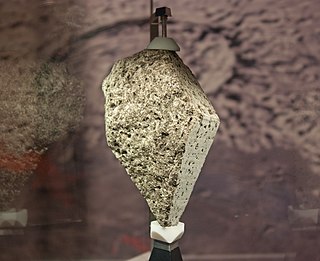
Moon rock or lunar rock is rock originating from Earth's Moon. This includes lunar material collected during the course of human exploration of the Moon, and rock that has been ejected naturally from the Moon's surface and landed on Earth as meteorites.

A lunar lander or Moon lander is a spacecraft designed to land on the surface of the Moon. As of 2024, the Apollo Lunar Module is the only lunar lander to have ever been used in human spaceflight, completing six lunar landings from 1969 to 1972 during the United States' Apollo Program. Several robotic landers have reached the surface, and some have returned samples to Earth.

A sample-return mission is a spacecraft mission to collect and return samples from an extraterrestrial location to Earth for analysis. Sample-return missions may bring back merely atoms and molecules or a deposit of complex compounds such as loose material and rocks. These samples may be obtained in a number of ways, such as soil and rock excavation or a collector array used for capturing particles of solar wind or cometary debris. Nonetheless, concerns have been raised that the return of such samples to planet Earth may endanger Earth itself.

The LK was a lunar module developed in the 1960s as a part of several Soviet crewed lunar programs. Its role was analogous to the American Apollo Lunar Module (LM). Three LK modules, of the T2K variant, were flown without crew in Earth orbit, but no LK ever reached the Moon. The development of the N1 launch vehicle required for the lunar flight suffered setbacks, and the first Moon landings were achieved by US astronauts on Apollo 11. As a result, having lost the Space Race, both the N1 and the LK programs were cancelled without any further development.


